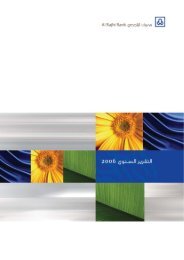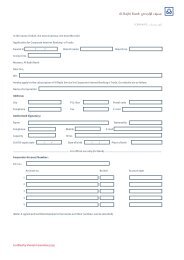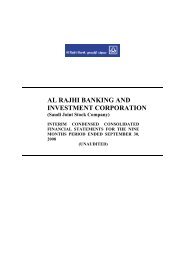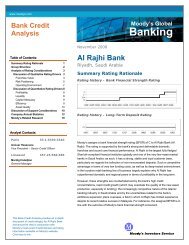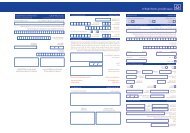Global Credit Research - Al Rajhi Bank
Global Credit Research - Al Rajhi Bank
Global Credit Research - Al Rajhi Bank
You also want an ePaper? Increase the reach of your titles
YUMPU automatically turns print PDFs into web optimized ePapers that Google loves.
At this stage, <strong>Al</strong> <strong>Rajhi</strong> has ample capital to support its business growth, both in the Kingdom and overseas, where<br />
organic, prudent and balanced expansion is the preferred option. More than sufficient capital is available to absorb<br />
any unexpected losses should the need arise.<br />
Going forward, we expect the capital adequacy ratios to remain robust, but to gradually decline, as a result of the<br />
joint effect of two simultaneous developments: on the one hand, the implementation of Basel II during 2008 will<br />
include, as per SAMA's guidelines, additional capital charges for pillar 2 risks, especially concentration risks,<br />
margin rate risk in the banking book, and macroeconomic risks; and on the other hand, as the bank expands<br />
domestically and internationally, equity growth might not be able to match the current expectation for rapid<br />
increases in risk-weighted assets. The bank has prepared for this scenario, and reduced its dividend payout ratios<br />
in recent years, in order to build additional capital cushions internally.<br />
The score for capital adequacy is A.<br />
Factor 8: Efficiency<br />
Trend: Neutral<br />
Despite its extensive network, <strong>Al</strong> <strong>Rajhi</strong>'s cost-to-income ratio was a low 26% in 2007, which compares very<br />
favourably to that of domestic and regional peers. The recent deterioration in the bank's efficiency indicators was<br />
largely expected given the recognition of unsustainable income in the revenue streams generated over the 2005-<br />
2006 period. However, current cost-to-income ratios are in line with the levels displayed pre-2005.<br />
<strong>Al</strong>though efficiency is robust at <strong>Al</strong> <strong>Rajhi</strong>, mainly due to relatively low labour costs, we have identified two<br />
weaknesses. On the one hand, given the limited use of variable components in compensation, costs tend to be<br />
sticky and of low flexibility across the cycle. On the other hand, we expect costs to grow faster than revenues in the<br />
medium term: indeed, <strong>Al</strong> <strong>Rajhi</strong>'s shift towards corporate banking should drive margins down, at a time when foreign<br />
expansion, further risk management upgrades and forays into still underdeveloped business lines (such as<br />
investment banking) might give rise to additional expenses. However, although slightly on the rise, efficiency ratios<br />
should remain among the most competitive in the country and the region as a whole.<br />
The bank scores A for its efficiency.<br />
Factor 9: Asset Quality<br />
Trend: Weakening<br />
The quality of <strong>Al</strong> <strong>Rajhi</strong>'s assets is adequate. Its non-performing loan ratios have deteriorated consistently over the<br />
past four years, rising to a moderate 3.5% at year-end 2007, after a sharp decline in 2004. Given that <strong>Al</strong> <strong>Rajhi</strong><br />
used to be heavily exposed to various forms of margin lending and credit against shares, the spectacular<br />
correction of the Saudi equity market that started in March 2006 was expected to contaminate the bank's credit<br />
portfolio, especially in its retail and commercial/SME components. Relative to its domestic peers, <strong>Al</strong> <strong>Rajhi</strong> displays<br />
lower asset quality indicators, partly reflecting its focus on catering for the needs of the retail mass-market.<br />
In the longer term, when the operating macroeconomic environment and credit portfolios mature, we would expect<br />
some further deterioration in asset quality to arise from the recent aggressive loan growth, as a result of which the<br />
bank's credit portfolio will have doubled between 2004 and 2008.<br />
At present, the score for the bank's asset quality is B but with a weakening trend.<br />
<strong>Global</strong> Local Currency Deposit Rating (Joint Default Analysis)<br />
Moody's assigns a long-term global local currency (GLC) deposit rating of A1 to <strong>Al</strong> <strong>Rajhi</strong>. This rating is supported<br />
by the bank's Baseline <strong>Credit</strong> Assessment of A3, as well as by the Aa3 local currency deposit ceiling of its<br />
underlying support provider, Saudi Arabia. This reflects our assessment of a very high probability of systemic<br />
support for the bank in the event of a stress situation, resulting in a two-notch uplift for this rating from the bank's<br />
Baseline <strong>Credit</strong> Assessment.<br />
Our support assessment is based on <strong>Al</strong>-<strong>Rajhi</strong>'s 12% market share in total assets, its status as the largest privatesector<br />
Islamic bank in the region as well as globally, and a track record that demonstrates that the Saudi<br />
authorities have always had a supportive approach to banks in distress. Moody's indeed views Saudi Arabia as a<br />
high support country.<br />
Notching Considerations<br />
Ratings for <strong>Al</strong> <strong>Rajhi</strong>'s junior obligations should be notched off the fully supported deposit rating because Moody's<br />
believes that there is no legal authority in place in Saudi Arabia to impose losses on subordinated creditors outside<br />
of a liquidation scenario.



